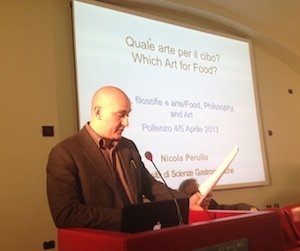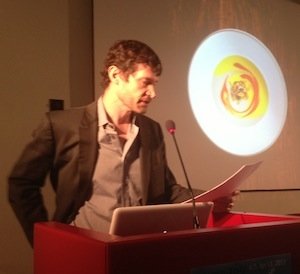There are more things in the sky and on earth, Horatio, than those your philosophy dreams of. For instance food, one would add to Hamlet’s admonition, after having attended the two day event called Convergence, a summit between philosophers, artists and chefs who have animated the Agenzia di Pollenzo, in the province of Cuneo, over the last weekend.
The objective was to trace the first shared circle around three disciplines – philosophy, art and food – while being aware that of course «the relation between food and art has been analysed since Plato», as Nicola Perullo, scientific director of the conference, and teacher of Aesthetics at the Università di Scienze gastronomiche, rightly reminded. But he also mentioned that during the following 2,500 years the edible experience has almost always been relegated by philosophers to the margins of the debate, excluded from the trivium and quatrivium, confined to a physiology of taste that was closer to lower instincts than to pure thought. Something to enjoy, or to laugh at, but not to think about longer that the time necessary to digest.
Pollenzo, however, has demonstrated that the time is right to put around the same table some very erudite semiologists and some illuminated chefs, food entrepreneurs and scholars of aesthetics, performers and journalists: «Even the fact of having highlighted that this possibility exists», concludes Perullo, «to me means this first edition can be considered a success». And we hope there will be a second edition, which will necessarily start from the bricks laid in these days. Let’s see which ones.

Nicola Perullo, Convergence scientific director and lecturer of Aesthetics at the Università di scienze gastronomiche in Pollenzo
Chef
Massimo Bottura has insisted on concepts thoroughly known at
Identità but which are worth repeating: culture is the first picklock necessary to break-transform-recreate the identity of Italian cuisine, in order to «fall in love with it once again», in order to «make the poetic invisible essence that is enclosed even in a pesto sauce, visible». The
German philosopher Harald Lemke, instead, has moved the scope to the ethical responsibility of our eating: «Western diet forces us to make some choices, such as renouncing to meat». With a conclusion that should, however, force vegetarians and vegans to get off the pedestal of the a-critic indignation: If «2,500 of Western culture still haven’t convinced us of the goodness of the vegetarian choice», this must mean something.
«Can you taste art?», was the question Ryan Bromley asked himself during his brilliant excursus on food in contemporary art. According to him, the road ahead is still long, since our culture is video-centric: «while our eyes can immediately tell a pen from a pencil, our taste needs more time to separate a pineapple from an orange». Which kind of art is suitable for food? - was the question posed by Perullo himself. For him, it is first of all necessary to remove any misunderstanding, perhaps starting from the rules of a game that would include «Food can be art only if elsewhere there’s a cuisine which is not art», or «only if we are freed from the cage of visual perception, considering food as something that doesn’t disappear but is transformed and transforms us».

Daniel Patterson, chef of Coi in San Francisco, author of a speech between aesthetics, poetics and language
And then there’s
Robert Valgent’s hermeneutical approach to cuisine,
Andrea Borghini’seating as a farmer’s act,
Lavazza’s excursions in the art of image, the «poetics of trade» by
Eataly’s merchant
Oscar Farinetti, the illuminating assimilation of cuisine to the orthodox rite, made by
semiologist Paolo Fabbri («food is a synthesis of all the arts: it is light, incense, image, fascination»), the poetics and aesthetics of the Californian chef
Daniel Patterson,
Andrea Petrini’s
Cosmopolis Redux epic, photographer
Bob Noto's easy-going shots, and finally
Davide Scabin’s harangue – that of the most designer among Italian artist-chefs.
All of them are experts in fields that are historically separated (if not in conflict) which, come to think about it, could make the 23rd and most important points in
Ferran Adrià’s
manifesto come true: «the collaboration between experts in different fields is essential to cuisine’s progress».